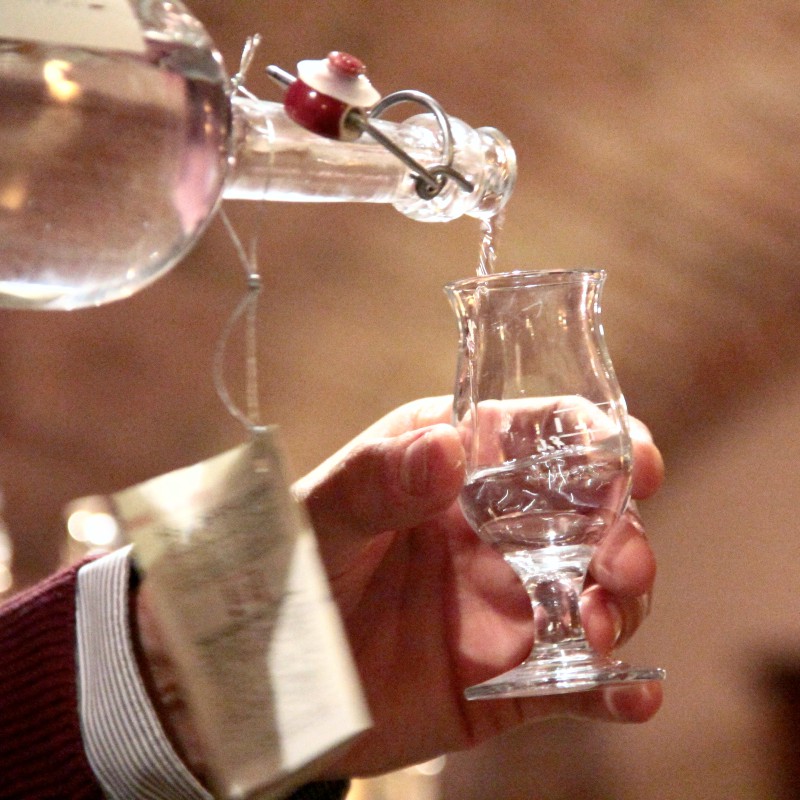Young Grappa
Grappa is defined as young or white when, after the processes of distillation and reduction in alcohol content, it is placed in steel containers and then bottled without any aging in wood or infusion of vegetal substances. The absence of aging and aromatization allows young Grappa to present itself with a crystalline appearance and transparency, making it a true delight to taste, offering a gustatory experience that celebrates the purity of freshly distilled pomace.
Grappa from White and Red Pomace
Perhaps not everyone knows that there is a further significant distinction within the category of young Grappa, depending on whether it comes from red grape pomace or white grape pomace.
This difference is not just a detail but defines the entire aromatic profile of the final product.
Red pomace (Merlot, Cabernet, Pinot Noir, etc.) has fermented together with its wine, transferring a significant portion of its aromas and flavors to the wine itself.
In contrast, white pomace (Pinot Grigio, Glera, Traminer, Moscato, etc.) undergoes separation from the must, allowing the skin to retain its aroma, which will then be concentrated during the distillation process.
The main distinction between red pomace (fermented) and white pomace (unfermented) lies in the richness of the primary aromas of the skin itself.
Young Grappa from white grapes is typically softer, more floral, and elegant, while Grappa from red pomace, with its aromatic complexity derived from fermentation with the wine, can captivate palates accustomed to drier, warmer, and more robust profiles.
Grappa from White and Red Pomace
Perhaps not everyone knows that there is a further significant distinction within the category of young Grappa, depending on whether it comes from red grape pomace or white grape pomace.
This difference is not just a detail but defines the entire aromatic profile of the final product.
Red pomace (Merlot, Cabernet, Pinot Noir, etc.) has fermented together with its wine, transferring a significant portion of its aromas and flavors to the wine itself.
In contrast, white pomace (Pinot Grigio, Glera, Traminer, Moscato, etc.) undergoes separation from the must, allowing the skin to retain its aroma, which will then be concentrated during the distillation process.
The main distinction between red pomace (fermented) and white pomace (unfermented) lies in the richness of the primary aromas of the skin itself.
Young Grappa from white grapes is typically softer, more floral, and elegant, while Grappa from red pomace, with its aromatic complexity derived from fermentation with the wine, can captivate palates accustomed to drier, warmer, and more robust profiles.
Aromatic Grappa
Among the young Grappa from white grape pomace, those distilled from aromatic or semi-aromatic grapes such as Moscato, Gewürztraminer, or Malvasia are defined as aromatic Grappa.
Fragrant and enveloping, these Grappa capture the essence of the aromatic grapes from which they are created, offering a particularly rich sensory palette of floral, fruity, and spicy notes.
Note: Aromatic Grappa should not be confused with flavored Grappa, which are pomace spirits that have undergone a natural infusion process with herbs or plants.
Under the Grappaiolo’s Lens: The White Grappa Test
Young Grappa is the ultimate test for the Master Distiller.
Want to assess their skill? Taste a young Grappa from their distillery. This experience offers an unparalleled opportunity to understand the distiller’s mastery in transferring all the delicate aromatic nuances of the pomace to the final product.
Among the young Grappa from white grape pomace, those distilled from aromatic or semi-aromatic grapes such as Moscato, Gewürztraminer, or Malvasia are defined as aromatic Grappa.
Fragrant and enveloping, these Grappa capture the essence of the aromatic grapes from which they are created, offering a particularly rich sensory palette of floral, fruity, and spicy notes.
Note: Aromatic Grappa should not be confused with flavored Grappa, which are pomace spirits that have undergone a natural infusion process with herbs or plants.
Under the Grappaiolo’s Lens: The White Grappa Test
Young Grappa is the ultimate test for the Master Distiller.
Want to assess their skill? Taste a young Grappa from their distillery. This experience offers an unparalleled opportunity to understand the distiller’s mastery in transferring all the delicate aromatic nuances of the pomace to the final product.



